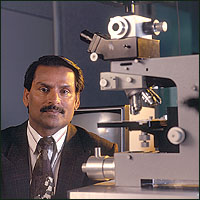Archives
Prasad named one of top 50 in science
By ELLEN GOLDBAUM
Contributing Editor
Paras N. Prasad, SUNY Distinguished Professor in the Department of Chemistry, has been named one of the Scientific American 50, the prestigious magazine's annual list of "outstanding acts of leadership in science and technology from the past year."

UB faculty member Paras N. Prasad has been honored by the prestigious magazine Scientific American as one of its top 50 scientists for 2005.
Prasad, executive director of UB's multidisciplinary Institute for Lasers, Photonics and Biophotonics, was selected for his research using customized nanoparticles developed by him and his colleagues to achieve gene therapy, avoiding the need to rely on potentially toxic viruses as vectors.
Selected by the magazine's board of editors and outside experts, the Scientific American 50 recognizes research, business and policy leaders. The list of the Scientific American 50 will appear in the December issue of Scientific American, which will be on newsstands on Nov. 22.
"The University at Buffalo is honored to have one of our distinguished faculty included among the Scientific American 50," said Jorge José, UB vice president for research.
"Dr. Prasad and his work are prime examples of the multidisciplinary focus that will guide the future of scientific research in the 21st century. The success of his efforts is demonstrated by the wide range of support he has received from the National Science Foundation, the National Institutes of Health, the New York State Office of Science, Technology and Academic Research and the Oishei Foundation, among others. He also has been in the forefront of efforts in translational research from the laboratory to the marketplace with tangible results for Western New York.
"This is a well-deserved recognition and we're very proud that Dr. Prasad is a member of our faculty," José said.
John Rennie, editor-in-chief of the magazine, said the Scientific American 50 is "our annual opportunity to salute the people and organizations worldwide whose research, policy or business leadership has played a major role in bringing about the science and technology innovations that are improving the way we live and offer the greatest hope for the future."
The magazine describes Prasad's research involving an animal model as providing new hope for fixing genetic defects.
Prasad and his colleagues used gene-nanoparticle complexes to activate adult brain stem/progenitor cells in vivo, demonstrating that it may be possible to "turn on" these otherwise idle cells as effective replacements for those destroyed by neurodegenerative diseases, such as Parkinson's.
The UB research, conducted by a multidisciplinary group including Michael K. Stachowiak, associate professor of pathology and anatomical sciences, also demonstrates that the nanoparticles can serve as promising models for studying the genetic mechanisms of the brain.
Other co-authors on the research are Dhruba J. Bharali, postdoctoral associate in the Department of Chemistry and at the institute; Ilona Klejbor, visiting scientist from the University of Gdansk; Ewa Stachowiak, research instructor, Department of Pathology and Anatomical Sciences; Purnendu Dutta, research associate at the institute; Earl J. Bergey, deputy director of biophotonics at the institute; Indrajit Roy, research assistant professor, Department of Chemistry; and Navjot Kaur, postdoctoral researcher, Department of Biochemistry.
The research is a critical part of the nanomedicine program of UB's Institute for Lasers, Photonics and Biophotonics.
Last month, Prasad was awarded a major National Cancer Institute grant aimed at developing nanotechnologies for earlier detection methods and more effective treatments for pancreatic cancer.
Prasad holds the Samuel P. Capen Chair at UB, as well as joint appointments in the departments of Physics, Medicine and Electrical Engineering in the College of Arts and Sciences, the School of Medicine and Biomedical Sciences and the School of Engineering and Applied Sciences.
In addition to his nanomedicine research, Prasad conducts pioneering research in the development and application of two-photon technology for biophotonics and 3-D microfabrication.
With 10 patents to his credit, he is the author of "Introduction to Biophotonics" and "Nanophotonics." The first two monographs to comprehensively address these fields, they were published to critical acclaim.
Prasad has published more than 500 scientific papers, co-edited six books and co-authored a monograph (with D.J. Williams), "Introduction to Nonlinear Optical Effects in Molecules and Polymers."
